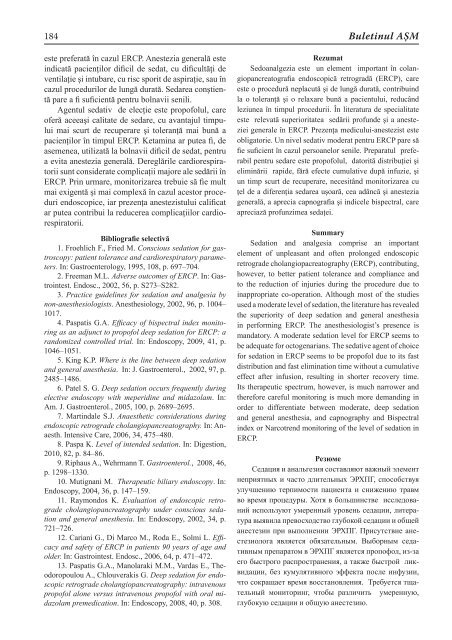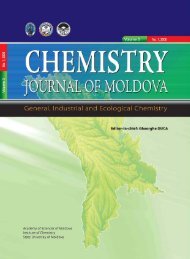stiinte med 3 2011.indd - Academia de ÅtiinÅ£e a Moldovei
stiinte med 3 2011.indd - Academia de ÅtiinÅ£e a Moldovei
stiinte med 3 2011.indd - Academia de ÅtiinÅ£e a Moldovei
Create successful ePaper yourself
Turn your PDF publications into a flip-book with our unique Google optimized e-Paper software.
184<br />
este preferată în cazul ERCP. Anestezia generală este<br />
indicată pacienţilor dificil <strong>de</strong> sedat, cu dificultăţi <strong>de</strong><br />
ventilaţie şi intubare, cu risc sporit <strong>de</strong> aspiraţie, sau în<br />
cazul procedurilor <strong>de</strong> lungă durată. Sedarea conştientă<br />
pare a fi suficientă pentru bolnavii senili.<br />
Agentul sedativ <strong>de</strong> elecţie este propofolul, care<br />
oferă aceeaşi calitate <strong>de</strong> sedare, cu avantajul timpului<br />
mai scurt <strong>de</strong> recuperare şi toleranţă mai bună a<br />
pacienţilor în timpul ERCP. Ketamina ar putea fi, <strong>de</strong><br />
asemenea, utilizată la bolnavii dificil <strong>de</strong> sedat, pentru<br />
a evita anestezia generală. Dereglările cardiorespiratorii<br />
sunt consi<strong>de</strong>rate complicaţii majore ale sedării în<br />
ERCP. Prin urmare, monitorizarea trebuie să fie mult<br />
mai exigentă şi mai complexă în cazul acestor proceduri<br />
endoscopice, iar prezenţa anestezistului calificat<br />
ar putea contribui la reducerea complicaţiilor cardiorespiratorii.<br />
Bibliografie selectivă<br />
1. Froehlich F., Fried M. Conscious sedation for gastroscopy:<br />
patient tolerance and cardiorespiratory parameters.<br />
In: Gastroenterology, 1995, 108, p. 697–704.<br />
2. Freeman M.L. Adverse outcomes of ERCP. In: Gastrointest.<br />
Endosc., 2002, 56, p. S273–S282.<br />
3. Practice gui<strong>de</strong>lines for sedation and analgesia by<br />
non-anesthesiologists. Anesthesiology, 2002, 96, p. 1004–<br />
1017.<br />
4. Paspatis G.A. Effi cacy of bispectral in<strong>de</strong>x monitoring<br />
as an adjunct to propofol <strong>de</strong>ep sedation for ERCP: a<br />
randomized controlled trial. In: Endoscopy, 2009, 41, p.<br />
1046–1051.<br />
5. King K.P. Where is the line between <strong>de</strong>ep sedation<br />
and general anesthesia. In: J. Gastroenterol., 2002, 97, p.<br />
2485–1486.<br />
6. Patel S. G. Deep sedation occurs frequently during<br />
elective endoscopy with meperidine and midazolam. In:<br />
Am. J. Gastroenterol., 2005, 100, p. 2689–2695.<br />
7. Martindale S.J. Anaesthetic consi<strong>de</strong>rations during<br />
endoscopic retrogra<strong>de</strong> cholangiopancreatography. In: Anaesth.<br />
Intensive Care, 2006, 34, 475–480.<br />
8. Paspa K. Level of inten<strong>de</strong>d sedation. In: Digestion,<br />
2010, 82, p. 84–86.<br />
9. Riphaus A., Wehrmann T. Gastroenterol., 2008, 46,<br />
p. 1298–1330.<br />
10. Mutignani M. Therapeutic biliary endoscopy. In:<br />
Endoscopy, 2004, 36, p. 147–159.<br />
11. Raymondos K. Evaluation of endoscopic retrogra<strong>de</strong><br />
cholangiopancreatography un<strong>de</strong>r conscious sedation<br />
and general anesthesia. In: Endoscopy, 2002, 34, p.<br />
721–726.<br />
12. Cariani G., Di Marco M., Roda E., Solmi L. Effi -<br />
cacy and safety of ERCP in patients 90 years of age and<br />
ol<strong>de</strong>r. In: Gastrointest. Endosc., 2006, 64, p. 471–472.<br />
13. Paspatis G.A., Manolaraki M.M., Vardas E., Theodoropoulou<br />
A., Chlouverakis G. Deep sedation for endoscopic<br />
retrogra<strong>de</strong> cholangiopancreatography: intravenous<br />
propofol alone versus intravenous propofol with oral midazolam<br />
pre<strong>med</strong>ication. In: Endoscopy, 2008, 40, p. 308.<br />
Buletinul AŞM<br />
Rezumat<br />
Sedoanalgezia este un element important în colangiopancreatografia<br />
endoscopică retrogradă (ERCP), care<br />
este o procedură neplacută şi <strong>de</strong> lungă durată, contribuind<br />
la o toleranţă şi o relaxare bună a pacientului, reducând<br />
leziunea în timpul procedurii. În literatura <strong>de</strong> specialitate<br />
este relevată superioritatea sedării profun<strong>de</strong> şi a anesteziei<br />
generale în ERCP. Prezenţa <strong>med</strong>icului-anestezist este<br />
obligatorie. Un nivel sedativ mo<strong>de</strong>rat pentru ERCP pare să<br />
fie suficient în cazul persoanelor senile. Preparatul preferabil<br />
pentru sedare este propofolul, datorită distribuţiei şi<br />
eliminării rapi<strong>de</strong>, fără efecte cumulative după infuzie, şi<br />
un timp scurt <strong>de</strong> recuperare, necesitând monitorizarea cu<br />
ţel <strong>de</strong> a diferenţia sedarea uşoară, cea adâncă şi anestezia<br />
generală, a aprecia capnografia şi indicele bispectral, care<br />
apreciază profunzimea sedaţei.<br />
Summary<br />
Sedation and analgesia comprise an important<br />
element of unpleasant and often prolonged endoscopic<br />
retrogra<strong>de</strong> cholangiopacreatography (ERCP), contributing,<br />
however, to better patient tolerance and compliance and<br />
to the reduction of injuries during the procedure due to<br />
inappropriate co-operation. Although most of the studies<br />
used a mo<strong>de</strong>rate level of sedation, the literature has revealed<br />
the superiority of <strong>de</strong>ep sedation and general anesthesia<br />
in performing ERCP. The anesthesiologist’s presence is<br />
mandatory. A mo<strong>de</strong>rate sedation level for ERCP seems to<br />
be a<strong>de</strong>quate for octogenarians. The sedative agent of choice<br />
for sedation in ERCP seems to be propofol due to its fast<br />
distribution and fast elimination time without a cumulative<br />
effect after infusion, resulting in shorter recovery time.<br />
Its therapeutic spectrum, however, is much narrower and<br />
therefore careful monitoring is much more <strong>de</strong>manding in<br />
or<strong>de</strong>r to differentiate between mo<strong>de</strong>rate, <strong>de</strong>ep sedation<br />
and general anesthesia, and capnography and Bispectral<br />
in<strong>de</strong>x or Narcotrend monitoring of the level of sedation in<br />
ERCP.<br />
Резюме<br />
Седация и анальгезия составляют важный элемент<br />
неприятных и часто длительных ЭРХПГ, способствуя<br />
улучшению терпимости пациента и снижению травм<br />
во время процедуры. Хотя в большинстве исследований<br />
используют умеренный уровень седации, литература<br />
выявилa превосходство глубокой седации и общей<br />
анестезии при выполнении ЭРХПГ. Присутствие анестезиолога<br />
является обязательным. Выборным седативным<br />
препаратом в ЭРХПГ является пропофол, из-за<br />
его быстрого распространения, а также быстрой ликвидации,<br />
без кумулятивного эффекта после инфузии,<br />
что сокращает время восстановления. Требуется тщательный<br />
мониторинг, чтобы различить умеренную,<br />
глубокую седации и общую анестезию.

















